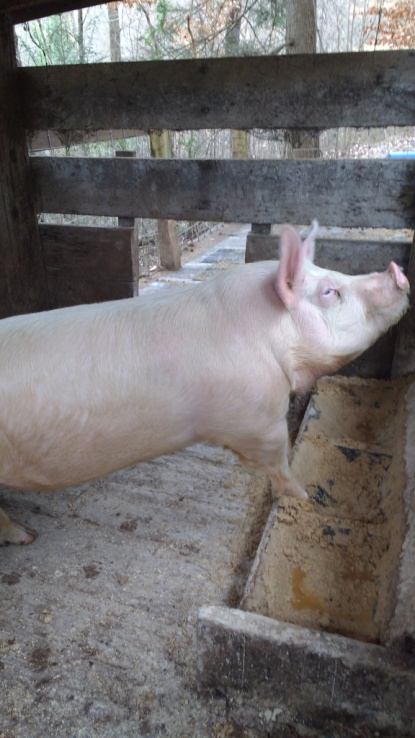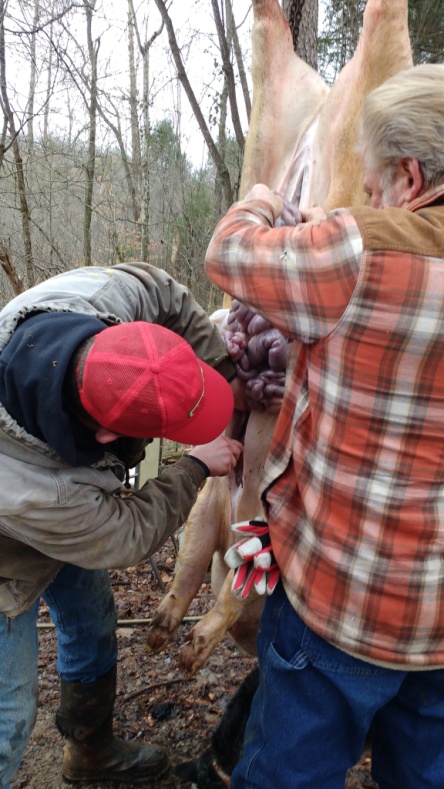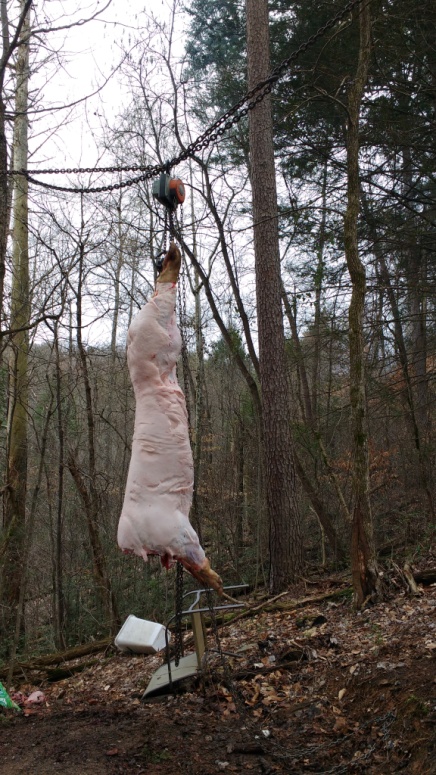Processing Pork Part Two: Preparing the Hog
Disclaimer: This post contains photos of the actual process of butchering meat. If you don’t want to see, just skip right over this post.
I hope you have found and read my introduction to this series. Read this post first if you haven’t yet!
It’s Important How You Prepare the Hog
The first step before anything else is…killing the pig. We raised our pig from a small piglet, bought from a local farmer the we love to support. The pig’s been with us for about six months. During this time, his only job has been to eat delicious scraps and feed. He’s been living in a very nice wooden pen, and lived luxuriously as a hog possibly can.

The hog is not disturbed as my husband does the final deed. He gets a single shot to the head and drops immediately. I’ll be saying this several more times throughout the post: the angle at which you shoot/cut is key. You have to be precise to do this correctly. In other words, you gotta know what you’re doing.
After the animal is dead, then, the hog is stuck from the neck into the heart, where the blood will drain sufficiently. This is important. You want the blood to drain right away. Again, the angle and depth of this cut needs to be precise to get the job done.
Moving the Hog to the Butchering Station
Now, they will tie a rope around him to pull him to the butchering station. My husband set up some chains and pulley to hoist the big hog up so he can be butchered easily.
After they pull him to the right spot, one cut is made into the skin on his back leg, above the foot. A long incision is made, and the tendon is visible. Once the tendon is felt and separated with a finger, one side of the gambling pole is stuck behind the tendon. This cut is made in the other back foot, and the pole is also placed behind the second tendon. Now the hog will be held up only by this gambling pole in between its feet.
They lift the hog up to the right height for working. I’ve always thought it was incredible that a 400-pound hog could be held up only by his tendons from his back feet. Pretty neat.

To Scald and Scrape or Skin?
Note: Most people back in the day would scald and scrape the hair off their hog. We choose to skin the hog. It’s just the method my husband prefers because it’s quicker and we don’t use the skin for anything anyways.
Once the hog is hanging properly, they hose off the mud and any other hog nasty, so they can have a relatively clean hog to work with.
Making A Proper Cut
Now it will be cut down the abdomen. As you can see, there is a layer of fat and muscle, not to mention connective tissues and membranes that have to be cut just right. My husband has done this many times and he knows the correct amount of pressure to put on the knife, and also the feel of the different layers. It’s hard to explain, but once you know the feel of the skin vs. muscle, or whatever, it’s easy to tell where to cut and how deep to cut.

The entrails will be cut out first. They will all fall out together if the correct cuts are made. My husband delicately works around the diaphragm to loosen the entrails. It’s very undesirable if an intestine or bladder is accidentally knicked. The intestines will fall out freely, but other organs like the heart require a little more loosening of tissue.
I wanted the heart, liver and kidneys out of the entrails, so I collected them and took them inside to the fridge. The rest is put in the throw away pile. (I used the heart and kidney in stew meat. Liver was made into this recipe for old-timey liver pudding.)
Then, they will cut around the neck until they can cut into the neck bone and separate the head. The head is set aside to work on later. (The head is made into souse meat.)
Moving Right Along…
After the hog is gutted and the head is off, it is skinned. He starts at the ankles, makes a round cut, and starts to peel back the hide. This is not a quick process. Usually, they will clamp the hide to a chain so it can be pulled with the help of a tractor or four-wheeler.

Now the pork is ready for the quartering and butchering. They will go ahead and take him down from the hanging position and set him up on a big table for easier quartering.
Be on the lookout for Part Three. Processing Pork: Butchering, Packaging, and Storing!
Also Read:



Processing Pork: Why Do We Do This? – J&R Farms
[…] Processing Pork Part Two: Preparing the Hog […]